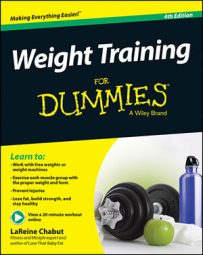Your triceps, located directly opposite your biceps, spans the rear of your upper arm. The biceps and triceps, like many muscle groups, work together in pairs. When you squeeze your biceps, your triceps relaxes and your arm bends, and when you squeeze your triceps, your biceps relaxes and your arm straightens.
Maintaining a good balance of strength in the relationship between the two muscles is important so that one muscle doesn’t dominate the other. That’s why you need to train both.
Triceps kickback
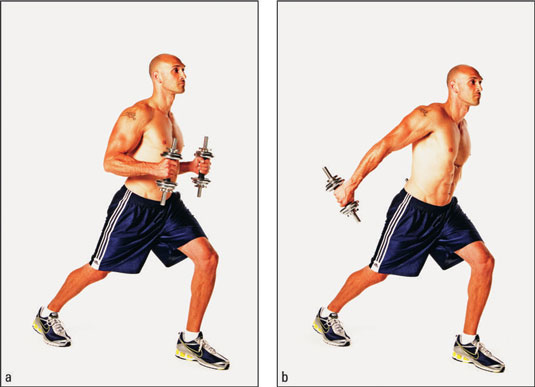
The triceps kickback works your triceps. Use caution if you have elbow or lower-back problems.
Hold a dumbbell in your right hand, and stand next to the long side of your bench. Lean forward at the hips until your upper body is at a 45-degree angle to the floor, and place your free hand on top of the bench for support.
Bend your right elbow so your upper arm is parallel to the floor, your forearm is perpendicular to the floor, and your palm faces in. Keep your elbow close to your waist. Pull your abdominals in and relax your knees.
Keeping your upper arm still, straighten your arm behind you until the end of the dumbbell is pointing down. Slowly bend your arm to lower the weight. When you’ve completed the set, repeat the exercise with your left arm.
Cable triceps kickback: Put the pulley on the topmost setting and attach a horseshoe handle. Grasping the handle in one hand, position yourself in the same way described in the basic kickback, and perform the same exercise. You may have to step a foot or two away from the cable tower to prevent the cable from going slack.
Triceps kickback with a twist (harder): As you straighten your arm, twist it so that at the top of the movement, your palm faces up.
Triceps pushdown
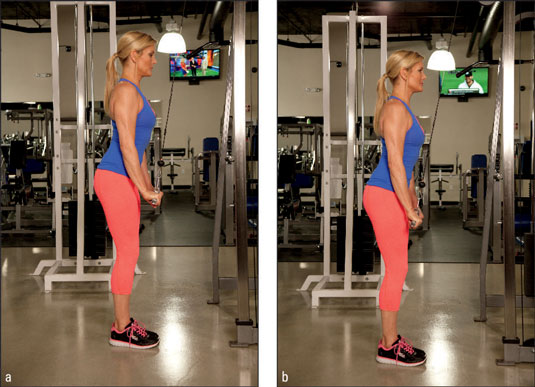
The triceps pushdown targets your triceps. Pay special attention to your form if you have elbow problems. Standing up straight with your abdominal muscles pulled in helps you avoid lower-back problems.
Set the pulley of the cable at the topmost setting and attach a straight or U-shaped bar. Grasp the bar with your palms facing down and your hands about a thumb’s distance from the center of the bar. You can stand either with your feet parallel or with one foot slightly in front of the other.
Bend your elbows so your forearms are parallel to the floor and your elbows are alongside your waist. You can lean slightly forward at the hips, but keep your abdominals pulled in and your knees relaxed.
Push the bar straight down, keeping your elbows close to your sides. Then bend your arms to allow the bar to rise slowly back to starting position.
One-hand triceps pushdown: Attach the horseshoe, and grasp it with one hand in an underhand grip. (You can also use an overhand grip, although it’s tougher.) Place your other hand on your hip. Straighten your arm, pushing the handle until it’s alongside your hip. Then slowly raise the handle back up.
Rope attachment (harder): Use the rope attachment, and move your hands a few inches apart as you press the rope down. You may need to use less weight with the rope than you do with a bar.
Bench dip
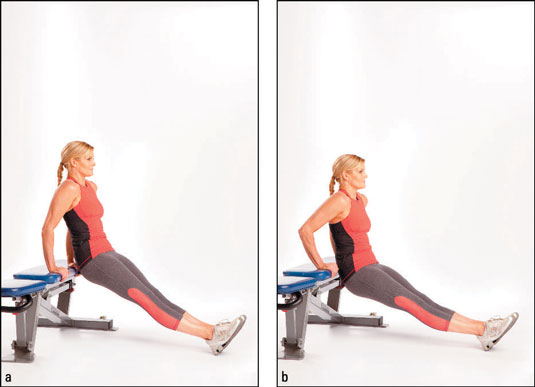
The bench dip is one of the few triceps exercises that strengthen other muscles, too — in this case, the shoulders and chest. Be careful if you have wrist, elbow, or shoulder problems.
Sit on the edge of a bench with your legs together and straight in front of you, pointing your toes upward. Keeping your elbows relaxed, straighten your arms, place your hands so you can grip the underside of the bench on either side of your hips, and slide your butt just off the front of the bench so your upper body is pointing straight down. Keep your abdominals pulled in and your head centered between your shoulders.
Bend your elbows and lower your body in a straight line. Hold for a few beats and then push yourself back up.
Bent-leg bench dip (easier): Instead of extending your legs out in front of you, bend your knees at a right angle so you’re positioned as if you’re sitting in a chair.
Feet-up bench dip (harder): Place your feet on another chair of equal height. Or, for an even tougher version, place a weight plate or dumbbell on your lap.
Triceps-dip machine
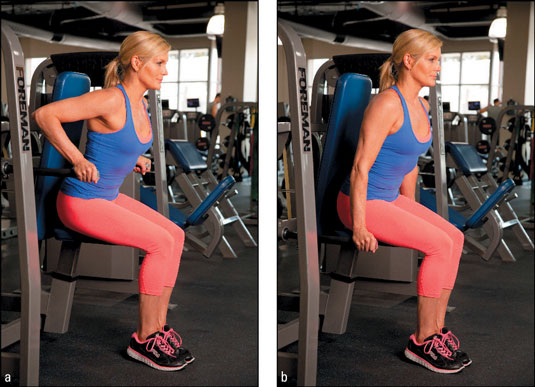
The triceps-dip machine targets your triceps and, to some extent, your shoulder and chest muscles. Take special care if you have shoulder, elbow, or neck problems.
Set the seat height so that when your arms are fully bent, your elbows are at or below chest level. Sit in the seat with your feet on the bar foot rest or flat on the floor. Grasp a handle in each hand so your elbows are bent and your palms are facing in. Pull your abdominals in and sit with your back, buttocks, and shoulder blades against the back support.
Press the handles down until your arms are straight. Slowly bend your arms until your elbows return to the starting position.
Different grips: Most triceps-dip machines have the option of a narrow or a wide grip. Start with the wide grip because you’re more likely to use correct form. However, when you become more proficient with this machine, the inside grip does an excellent job of isolating the triceps muscles.
Modified triceps-dip machine: You can raise the seat higher to restrict the distance your arms travel. This variation is an excellent option for those with neck and shoulder problems because the raised seat keeps you from raising your arms too high and ensures that the neck and shoulders won’t be hunched and tight.
Triceps-extension machine: Some gyms have a triceps-extension machine rather than a triceps-dip machine. The extension machine works the muscles the same way except that you start with your arms at shoulder height with your elbows resting on a pad; then you press the handles, straightening your arms out in front of you instead of downward.

